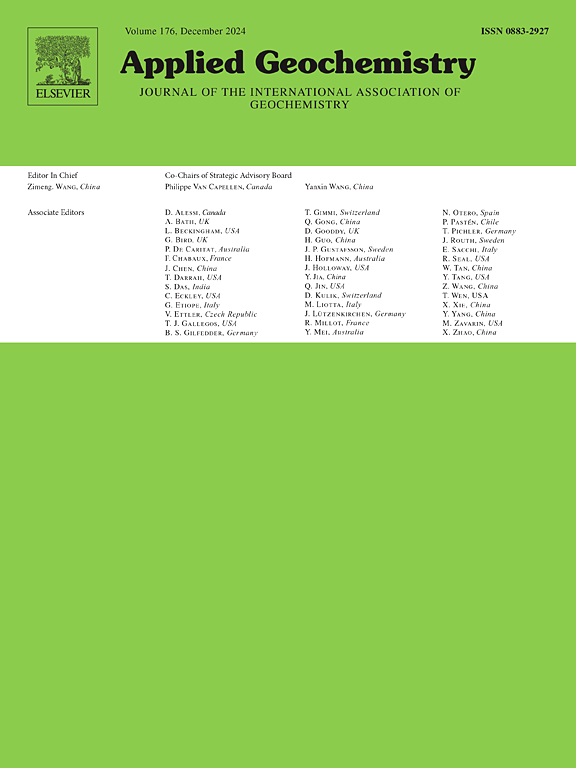哥伦比亚安蒂奥基亚受金矿开采影响地区潜在有毒元素造成的人类健康风险概率评估
IF 3.4
3区 地球科学
Q1 GEOCHEMISTRY & GEOPHYSICS
引用次数: 0
摘要
本研究的目的是确定哥伦比亚安蒂奥基亚三个市受金矿开采影响地区土壤样本中潜在有毒元素(pte)浓度与人类健康风险(非致癌性和致癌性)的概率关系。采集研究区土壤样品,分析砷、镉、铅和铬的浓度。通过在户外活动中偶然的土壤摄入和皮肤接触,评估了成人和儿童对这些pte的暴露。为了评估潜在的不良健康影响,使用危害指数(HI)和总癌症风险(TCR)分析了pte浓度。砷、镉、铅和铬的最小和最大浓度分别为1.7 ~ 892 mg kg - 1、0.1 ~ 65.2 mg kg - 1、13.0 ~ 2345 mg kg - 1和5.4 ~ 301 mg kg - 1。概率风险分析表明,HQ和CR值高于安全暴露阈值,表明如果暴露条件保持不变,暴露于污染土壤的居民可能面临健康风险。结果表明,在Puerto Berrío和buritic本文章由计算机程序翻译,如有差异,请以英文原文为准。

Probabilistic human health risk assessment due to potential toxic elements in gold mining-affected areas of Antioquia, Colombia
The purpose of this study was to determine the probabilistic human health risk (both non-carcinogenic and carcinogenic) associated with the concentration of potentially toxic elements (PTEs) in soil samples from gold mining-impacted areas in three municipalities of Antioquia, Colombia. Soil samples were collected from the study area, and the concentrations of As, Cd, Pb, and Cr were analyzed. Human exposure to these PTEs was assessed for both adults and children through incidental soil ingestion and dermal contact during outdoor activities. To evaluate the potential adverse health effects, PTEs concentrations were analyzed using the Hazard Index (HI) and Total Cancer Risk (TCR). The minimum and maximum concentrations of As, Cd, Pb, and Cr were 1.7–892 mg kg−1, 0.1–65.2 mg kg−1, 13.0–2345 mg kg−1, and 5.4–301 mg kg−1, respectively. The probabilistic risk analysis indicated HQ and CR values above the safe exposure threshold, suggesting that, if exposure conditions are maintained, residents exposed to contaminated soils may face risks to their health. The results indicate that in Puerto Berrío and Buriticá, a significant proportion of children are exposed to non-carcinogenic risk levels far exceeding safe limits, with Puerto Berrío being the most critical area, where exposure levels surpass the safety threshold by up to 40 times. Overall, the findings of this study provide new scientific evidence that can support data-driven decision-making for the development of regulations and improved environmental management strategies.
求助全文
通过发布文献求助,成功后即可免费获取论文全文。
去求助
来源期刊

Applied Geochemistry
地学-地球化学与地球物理
CiteScore
6.10
自引率
8.80%
发文量
272
审稿时长
65 days
期刊介绍:
Applied Geochemistry is an international journal devoted to publication of original research papers, rapid research communications and selected review papers in geochemistry and urban geochemistry which have some practical application to an aspect of human endeavour, such as the preservation of the environment, health, waste disposal and the search for resources. Papers on applications of inorganic, organic and isotope geochemistry and geochemical processes are therefore welcome provided they meet the main criterion. Spatial and temporal monitoring case studies are only of interest to our international readership if they present new ideas of broad application.
Topics covered include: (1) Environmental geochemistry (including natural and anthropogenic aspects, and protection and remediation strategies); (2) Hydrogeochemistry (surface and groundwater); (3) Medical (urban) geochemistry; (4) The search for energy resources (in particular unconventional oil and gas or emerging metal resources); (5) Energy exploitation (in particular geothermal energy and CCS); (6) Upgrading of energy and mineral resources where there is a direct geochemical application; and (7) Waste disposal, including nuclear waste disposal.
 求助内容:
求助内容: 应助结果提醒方式:
应助结果提醒方式:


